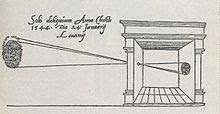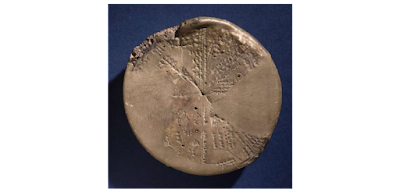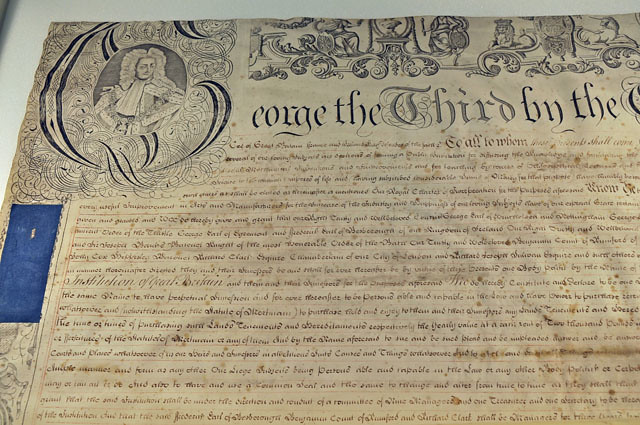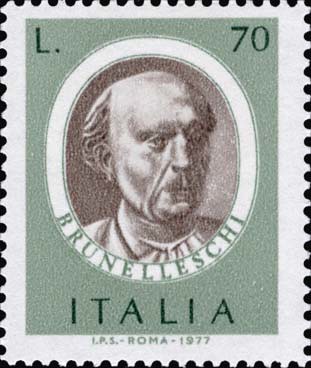Max Rosenlicht
The 181st day of the year; 181 is the 9th palindromic prime number.
1f you square 181 and add 7, you get 32768. So what? Well 32768 is 215. STILL not impressed? The only other numbers for which n2 + 7 is a power of 2 are 1, 3, 5, and 11.... full stop. And to take this beyond the coincidental, if you replace the 7 with any other integer, there will never be more than two solutions.
and the 181-digit palindromic number made up of all 7's except for the center being 181 (7777...7718177...77777) is a palindromic prime with a palindromic prime decimal length.
181 is the both the difference and the sum of consecutive squares:
\( 181 = 91^2 – 90^2 = 9^2 + 10^2 \)
Every natural number greater than 181 can be written as sum of cubes of the first two primes. (students might be asked to find all examples of numbers less than 181 that can be written in this fashion, such as 35= 23 + 33)
More Math Facts for every year day here.
1601. Johannes Kepler uses a camera obscura of his own design set up in a tent to view solar eclipses in Graz on 30 June 1601 . Infamously whilst he was busy observing the solar eclipse on the market place in Graz a thief stole his purse with thirty silver florins. It was Kepler that coined the name camera obscura. The earliest use of the term "camera obscura" is found in his 1604 book, Ad Vitellionem Paralipomena.*RMAT Art Historian J V Field has suggested that in the same book he invented two other math/science ideas: "The two inventions in question are the point at infinity’ and the retinal image. The first is apparently merely mathematical whereas the second is certainly conceived as having physical existence, but the two processes of invention are both closely bound up with Kepler’s conception of the role of mathematical reasoning in natural philosophy, and they consequently have much in common. "
 |
| Camera Obscura design of Gemma Frisius,16th C |
1686 The Royal Society made the decision to publish De Historia Piscium, a lavishly-illustrated history of fishes by John Ray and Francis Willughby. The books was beautiful, but turned out to be such a poor seller that the Society almost went bankrupt. At one point Edmond Halley's salary could not be paid during the same period when he was trying to get Newton to complete his epic masterpiece, The Principia. Fortunately for science, Halley accepted a deal for something like one-hundred copies of the fish book, and then mostly funded the publication of Newton's classic himself over the next year. I don't know if Halley ever managed to sell any of the De Historia Piscium that he took in lieu of salary. *PB old notes.
1737 John Harrison, after positive results on the test of his first sea-clock, receives the first money awarded by the Board of Longitude (23 years after the Act to create the Board). Harrison received 500 Pounds, 250 Pounds to be paid immediately, and another 250 Pounds after completing a second clock that passes testing at sea. *Derek Howse, Britain's Board of Longitude: The Finances 1714-1828
 |
| Harrison's H2 |
1742 Euler replied (see June 7 post) in a letter dated 30 June 1742, and reminded Goldbach of an earlier conversation they had ("...so Ew vormals mit mir communicirt haben.."), in which Goldbach remarked his original (and not marginal) conjecture followed from the following statement, “Every even integer greater than 2 can be written as the sum of two primes,” which is thus also a conjecture of Goldbach. In the letter dated 30 June 1742, Euler stated:“Dass ... ein jeder numerus par eine summa duorum primorum sey, halte ich für ein ganz gewisses theorema, ungeachtet ich dasselbe necht demonstriren kann.” ("every even integer is a sum of two primes. I regard this as a completely certain theorem, although I cannot prove it.")*Wik
As of this date, no one else has proved it either. It is one of the oldest open questions in mathematics.
Euler also claimed that prime numbers of the form 4n+ 1 are represented uniquely as a sum of two squares. He also mentions that 641 divides 232 + 1, thereby disproving Fermat’s claim that all numbers Fermat numbers F(n)= \( 2^{2^n}+1\) are prime. Years later we have not found another which is prime.
1812 Congress authorized the President of the US to issue interest bearing Treasury Notes for the first time in history. The interest was fixed at "five and two-fifths per centum a year." *Kane, Famous First Facts (students might calculate the present value of a $100 investment on that date compounded to the present)
1808 Sir Humphrey Davy announced the discovery of magnesium (Mg), calcium (Ca), strontium (Sr) and barium (Ba) on this day in 1808
Throughout his career Davy isolated several metal elements from their compounds through the process of electrolysis, using a primitive electrical battery called a voltaic pile.
Davy also announced he had separated the element boron. However, working independently, French chemist, Joseph Louis Gay-Lussac had announced* the same accomplishment nine days earlier, on 21 Jun 1808. *TIS
1860 Oxford evolution debate took place at the Oxford University Museum on 30 June 1860, seven months after the publication of Charles Darwin's On the Origin of Species. Several prominent British scientists and philosophers participated, including Thomas Henry Huxley, Bishop Samuel Wilberforce, Benjamin Brodie, Joseph Dalton Hooker and Robert FitzRoy.
The debate is best remembered today for a heated exchange in which Wilberforce supposedly asked Huxley whether it was through his grandfather or his grandmother that he claimed his descent from a monkey. Huxley is said to have replied that he would not be ashamed to have a monkey for his ancestor, but he would be ashamed to be connected with a man who used his great gifts to obscure the truth *Wik
1894 Tower Bridge opens, In 1886, the foundation stone of the Tower Bridge in London, England was laid (over a time capsule) by the Prince of Wales. The need to cross the River Thames at this point had become increasingly urgent for many years, and finally the necessary Act was passed in 1885. The bridge, designed by Mr. Wolfe Barry, CB, was completed at a cost of about £1,000,000. To permit the passage of tall ships between the towers, two bascule spans, each of 100-ft length, are raised. The side spans to the towers are of the more familiar suspension type. Pedestrians can traverse a high-level footway nearly at the top of the towers, even when the bridge is raised. It was officially opened 30 Jun 1894, by the Prince of Wales, later Edward VII, on behalf of Queen *TIS
1905 Albert Einstein's paper, "On the electrodynamics of moving bodies" (special relativity) is received at the Journal Annalen der Physik.
"Einstein develops the special theory of relativity in this paper. His concern, as he makes clear in the introduction, is that then current electrodynamics harbors a state of rest, the ether state of rest, and the theory gives very different accounts of electrodynamic processes at rest or moving in the ether. But experiments in electrodynamics and optic have provided no way to determine which is the ether state of rest of all inertial state of motion. Einstein shows that Maxwell-Lorentz electrodynamics has in fact always obeyed a principle of relativity of inertial motion. We just failed to notice it since we tacitly thought that space and time had Newtonian properties, not those of special relativity. " *John D Norton, Einstein, 1905, Pitt.edu
1908 A Comet(?) explodes above Tunguska, Siberia. *VFR In 1908, at around 7:15 am, northwest of Lake Baikal, Russia, a huge fireball nearly as bright as the Sun was seen crossing the sky. Minutes later, there was a huge flash and a shock wave felt up to 650 km (400 mi) away. Over Tunguska, a meteorite over 50-m diameter, travelling at over 25 km per second (60,000 mph) penetrated Earth's atmosphere, heated to about 10,000 ºC and detonated 6 to10 km above the ground. The blast released the energy of 10-50 Megatons of TNT, destroying 2,200 sq km of forest leaving no trace of life. The Tunguska rock came out of the Taurid Meteor storm that crosses Earth's orbit twice a year. The first scientific expedition for which records survive was made by Russian mineralogist Leonid Kulik in 1927. *TIS
1945 The first distribution of John von Neumann's First Draft of a Report on the EDVAC, containing the first published description of the logical design of a computer with stored-program and instruction data stored in the same address space within the memory (von Neumann architecture)*Wik
1946 ENIAC formally accepted by the government. See 2 October 1955*VFR
1948 Encouraged by Executive Vice President Mervin Kelly, William Shockley returned from wartime assignments in early 1945 to begin organizing a solid-state physics group at Bell Labs. Among other things, this group pursued research on semiconductor replacements for unreliable vacuum tubes and electromechanical switches then used in the Bell Telephone System. That April he conceived a "field-effect" amplifier and switch based on the germanium and silicon technology developed during the war, but it failed to work as intended. A year later theoretical physicist John Bardeen suggested that electrons on the semiconductor surface might be blocking penetration of electric fields into the material, negating any effects. With experimental physicist Walter Brattain, Bardeen began researching the behavior of these "surface states."
 |
| *CHM |
1954 Solar eclipse in Britain. The about 3 minutes totality was visible in the Faroes and the southern line was crossing the northernmost Shetland. Many people in England do remember this eclipse and is often mistaken as total for those who saw a large partial eclipse. The eclipse track traveled across Norway, Sweden, Lithuania, Byelorussia, and Russia. *NSEC
1955 Sperry Rand formed. In 1955 Sperry acquired Remington Rand and renamed itself Sperry Rand. Acquiring then Eckert-Mauchly Computer Corporation and Engineering Research Associates along with Remington Rand, the company developed the successful UNIVAC computer series and signed a valuable cross-licensing deal with IBM. *Wik
1972 The International Time Bureau adds the first leap second to Coordinated Universal Time (UTC). *Wik
1973

A group of scientist boarded a prototype French Concorde airplane to chase a solar eclipse. The eclipse promised a luxurious view if you stood at the right place on the planet: a maximum of 7 minutes and 4 seconds as the moon passed over the Sahara Desert. It would be just 28 seconds short of the longest possible eclipse viewable from Earth; in the preceding several hundred years, there had only been one eclipse longer than this one, and there would not be a longer total solar eclipse until June 2150. Not satisfied with one of the longest eclpises in recent history, the group managed to negotiate a viewing flight on the still in testing Concorde. Closing in at maximum velocity, Concorde would swoop down from the north and intercept the shadow of the moon over northwest Africa. Traveling together at almost the same speed, Concorde would essentially race the solar eclipse across the surface of the planet, giving astronomers an unprecedented opportunity to study the various phenomena made possible by an eclipse. In one flight, Concorde had given astronomers more eclipse observing time than all the previous expeditions last century—generating three articles in Nature and a wealth of new data. *Motherboard
 2011 Mr Ballew finally hung up his spurs and rode off into the sunset with his sweetheart, Jeannie.
2011 Mr Ballew finally hung up his spurs and rode off into the sunset with his sweetheart, Jeannie.2015 A Leap second is added to the clock in the last second before 8pm, so there will be a minute with 61 seconds. Between 1972 and 2012, a leap second has been inserted about every 18 months, on average. However, the spacing is quite irregular and apparently increasing: there were no leap seconds in the seven-year interval between January 1, 1999 and December 31, 2005, but there were nine leap seconds in the eight years 1972–1979. *Wik
He published in 1770 an account of a voyage to America in 1768, undertaken as the commissary of the French Academy of Sciences with a view to testing Pierre Le Roy’s watches at sea. A memoir in which he described the operations superintended by him in 1787 for connecting the observatories of Paris and Greenwich by longitude-determinations appeared in 1791. He visited England for the purposes of the work, and saw William Herschel at Slough. He completed his father’s map of France, which was published by the Academy of Sciences in 1793. It served as the basis for the Atlas National (1791), showing France in departments.
Cassini’s Mémoires pour servir à l’histoire de l’observatoire de Paris (1810) embodied portions of an extensive work, the prospectus of which he had submitted to the Academy of Sciences in 1774. The volume included his Eloges of several academicians, and the autobiography of his great-grandfather, Giovanni Cassini.*Wik
1791 Félix Savart (June 30, 1791, Charleville-Mézières, Ardennes – March 16, 1841, Paris) became a professor at Collège de France in 1836 and was the co-originator of the Biot-Savart Law, along with Jean-Baptiste Biot. Together, they worked on the theory of magnetism and electrical currents. Their law was developed about 1820. The Biot-Savart Law relates magnetic fields to the currents which are their sources. Félix Savart also studied acoustics. He developed the Savart wheel which produces sound at specific graduated frequencies using rotating disks.
Félix Savart is the namesake of the unit of measurement for musical intervals, the savart, though it was actually invented by Joseph Sauveur.*Wik
1856 Cargill Knott (June 30, 1856 – October 26, 1922) born. He graduated from Edinburgh University and was then an assistant in the Physics department. With Barclay and Fraser he was one of the writers who originally proposed the founding of the EMS. He went to the Imperial University in Tokyo as Professor. He returned to a lectureship in Edinburgh and eventually became a Reader in Applied Mathematics. He became Secretary and Treasurer of the EMS in 1883 and President in 1893 and 1918.*SAU
1880 Birthdate of Rudolf Fueter (30 June 1880 in Basel; 9 August 1950 in Brunnen) who worked with functions with non-commutative variables and also in number theory. *SAU
1919 John William Strutt 3rd Baron of Rayleigh (of Terling Place)(12 November 1842 – 30 June 1919) was an English physical scientist who made fundamental discoveries in the fields of acoustics and optics that are basic to the theory of wave propagation in fluids. He received the Nobel Prize for Physics in 1904 for his investigations into the densities of the most important gases and his successful isolation of argon, an inert atmospheric gas.*TIS
Credits
*CHM=Computer History Museum
*FFF=Kane, Famous First Facts
*NSEC= NASA Solar Eclipse Calendar
*RMAT= The Renaissance Mathematicus, Thony Christie
*SAU=St Andrews Univ. Math History
*TIA = Today in Astronomy
*TIS= Today in Science History
*VFR = V Frederick Rickey, USMA
*Wik = Wikipedia




























